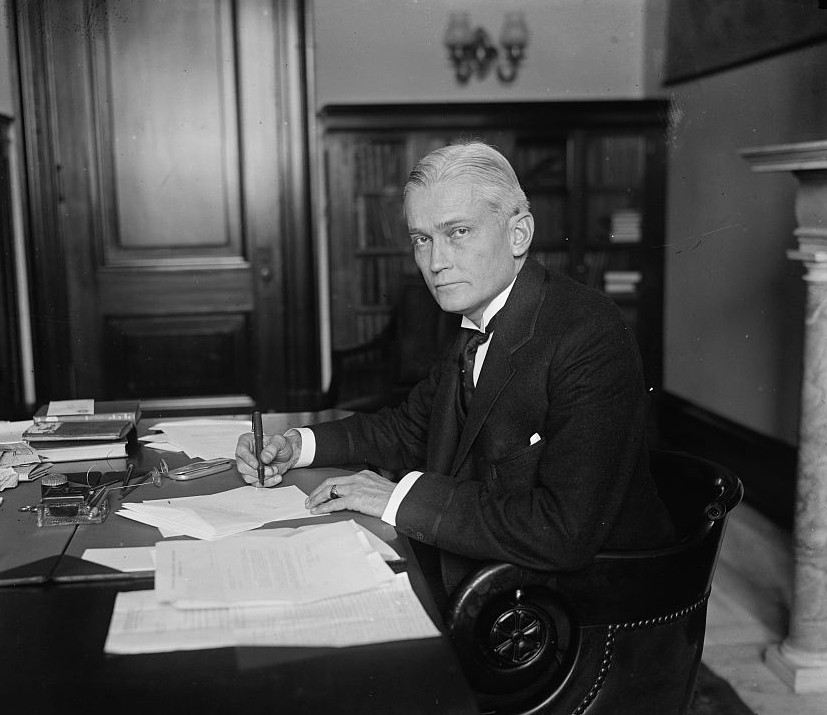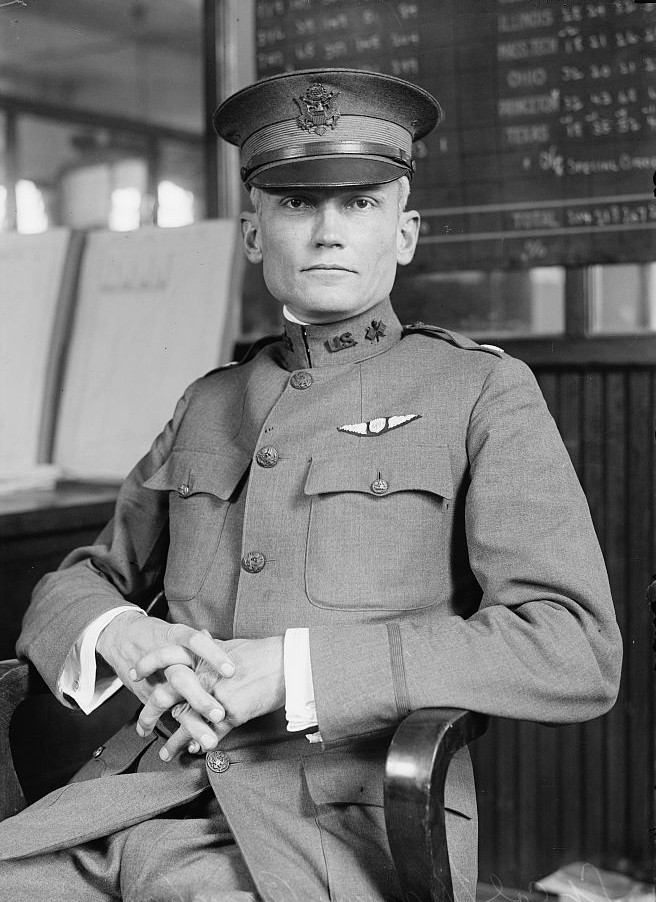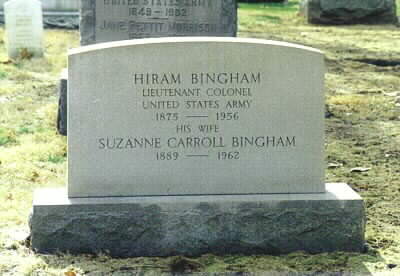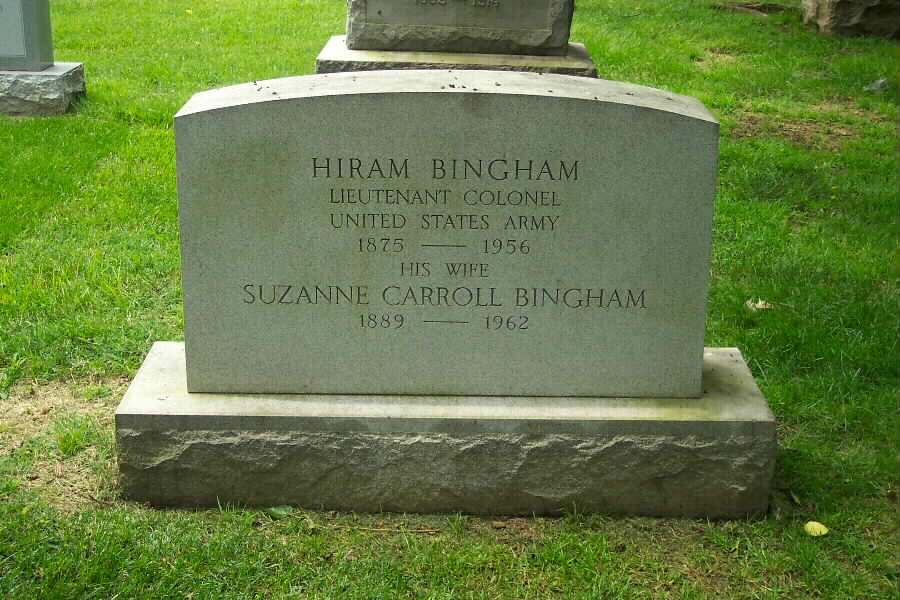Courtesy of the Congress of the United States:
BINGHAM, Hiram, (father of Jonathan Brewster Bingham), a Senator from Connecticut; born in Honolulu, Hawaii, November 19, 1875; educated at Punahou School and Oahu College, Hawaii, 1882-1892, Phillips Academy, Andover, Mass., 1892-1894, Yale University 1894-1898, University of California at Berkeley 1899-1900, and Harvard University 1900-1905; professor of history and politics at Harvard and then Princeton Universities; South American explorer, credited with the discovery of the Incan ruins at Machu Picchu; delegate to the First Pan American Scientific Congress at Santiago, Chile, in 1908; captain, Connecticut National Guard 1916; became an aviator in the spring of 1917; organized the United States Schools of Military Aeronautics in May 1917; served in the Aviation Section, Signal Corps, and attained the rank of lieutenant colonel; commanded the flying school at Issoudun, France, from August to December 1918; lieutenant governor of Connecticut 1922-1924; elected Governor of Connecticut on November 4, 1924 but served only briefly; elected as a Republican to the United States Senate on December 16, 1924, to fill the vacancy caused by the death of Frank B. Brandegee in the term ending March 3, 1927; reelected in 1926 and served from December 17, 1924, to March 3, 1933; unsuccessful candidate for reelection in 1932; chairman, Committee on Printing (Seventieth Congress), Committee on Territories and Insular Possessions (Seventieth through Seventy-second Congresses); censured by the Senate in 1929 on charges of placing of a lobbyist on his payroll; appointed a member of the President’s Aircraft Board by President Calvin Coolidge 1925; engaged in banking and literary work in Washington, D.C.; during the Second World War, lectured at naval training schools 1942-1943; chairman of the Civil Service Commission’s Loyalty Review Board 1951-1953; died in Washington, D.C., June 6, 1956; interment in Arlington National Cemetery, Arlington, Va.
Hiram Bingham was born on November 19, 1875 in Honolulu, Hawaii and was descended from Deacon Thomas Bingham, who had come to the American colonies in the year 1650 and settled in Connecticut. His grandfather lived from 1789-1869 and was the first Protestant missionary to go to the Hawaiian Islands. His father, who was also a missionary, is mostly remembered for his work in the Gilbert Islands and his translation of the Bible into Gilbertese.
Hiram had a good education and had many jobs throughout his life. He attended the Punahou School of Oahu College for 10 years and the Phillips Academy for 2 years before entering Yale University. He received his B.A. degree from Yale University in 1898 and for 8 months afterward served as a superintendent of a mission
in Honolulu. For the next four months, he was a chemist with the American Sugar Company. He then went back to school, first at the University of California, then Harvard for postgraduate study in history and political science. Bingham attained his Ph.D. from Harvard in 1905 and then spent one year as a Preceptor at
Princeton.
In November 1906 Bingham sailed to South America to follow the route Bolivar (an explorer Bingham had studied) had taken in 1819. He wrote about his travels and his writings were published under the title Journal of an Expedition Across
Venezuela and Columbia. Next, he explored the old Spanish trade route from Buenos Aires, Argentina to Lima, Peru. His writings of that journey were published in 1911 and were entitled Across South America. In 1911, Bingham again set out for
South America, this time as the Director of the Peruvian Expedition. On this expedition he located the site of the last Inca capital Vitcos.; He was the first to ascend the 21,763 ft. Mt. Coropuma. The following year Bingham made another discovery, perhaps his most important one, the discovery of Machu Picchu, the “lost city.”
As World War I began, Bingham turned to politics and the military as a way of life. He attended the Republican National Convention as Connecticut’s alternate and was chosen as an elector on the Hughes-Fairbanks ticket. Hiram served as an
officer in various military roles, eventually being promoted to Lieutenant Colonel and serving as Commanding Officer at the Aviation International Center in France.
In the summer of 1920, he was again an alternate for the Republican National Convention and was marked for advancement. Two years later he was elected Lieutenant Governor. For two days he was the Governor of Connecticut but left his job for an opening in the U.S. Senate. Bingham was a U.S. Senator for eight years but lost his seat to Democrat Augustine Lonergan which ended his political career.
Later, Bingham had many other jobs. Some of those jobs were serving on the Board of the Washington Loan and Trust Company, Vice President of the Colmena Oil Company, writing two biographies, giving many lectures on the South Sea
Islands at Naval Training stations, and Chairman of the Loyalty Review Board.
Hiram Bingham married Alfreda Mitchell on November 20, 1900 and had 7 sons. He later got divorced and in June 1937 Bingham married Suzanne Carroll Hill. Bingham was a member of the Royal Geographical Society and the National Geographical Society. Bingham was also a member of the Sigma Psi Fraternity.
Courtesy of The Day.Com
1 October 2007
Hiram Bingham III has been in the news lately. After years of negotiations, Yale University recently agreed to return to Peru a large collection of artifacts which he excavated in 1912 from the Inca ruins at Machu Picchu, artifacts claimed by the Peruvian government. (The Day, Sept. 17, 2007, “Yale, Peru agree on return of artifacts.”) His colorful years as an explorer may have been the model for the popular Indiana Jones movies. His life was filled with excitement and he achieved success in a wide variety of careers.
Consulting the latest edition of our Connecticut State Register and Manual, the famed “blue book,” I found that this college professor explorer, also an accomplished aviator, served as governor of our state for just one day, the shortest term in our history. (John Winthrop Jr., founder of New London, served the longest—18 years.) Bingham gave up this choice position in favor of the United States Senate. And that’s not all he did with his life.
His story is not the usual tale of local boy makes good. Headlines were routine for him. To begin with, he was born in Honolulu, Hawaii on November 19, 1875. His grandfather, also Hiram, was the first Protestant missionary to Hawaii. His father, Hiram Jr., was a missionary in the Gilbert Islands.
And our future governor, the third Hiram, supervised a Honolulu mission after his graduation from Yale in 1898 before he worked for the American Sugar Company. Later he studied at Berkeley and received a Ph.D. from Harvard.
In 1900 he married Alfreda Mitchell at the Mitchell home in New London, now part of Mitchell College. She was the granddaughter of Charles L. Tiffany, founder of Tiffany & Co.
The couple had seven handsome sons. It’s probable that the Tiffany fortune may have had a part in shaping his many careers. After the marriage, with a new interest in South American history, Bingham began his period of teaching and exploration which led to the discovery of Machu Picchu during expeditions for Yale University. He published several books about his travels.
Ready for new fields with the outbreak of World War I in Europe, Hiram Bingham became interested in the preparedness movement. He joined the Connecticut National Guard in 1916, commissioned as captain. The following year at the age of 42 he decided to learn to fly, and won his wings as a pilot. He became chief of personnel in the Army Air Service and saw duty in France.
After the war he entered the political scene, attending the Republican national convention as an alternate from Connecticut. In 1922 he was nominated for lieutenant governor of Connecticut, receiving plaudits as a college professor running for public office. His slate easily won. Next, with the support of J. Henry Roraback, Republican party chairman, he was named Republican candidate for governor in 1924.
A handsome and appealing man, he campaigned vigorously throughout the state. My late husband, Burton Kimball, grew up in the little town of Scotland, Connecticut. He often recalled the day Hiram Bingham came there to speak at an outdoor meeting. Burton’s parents were staunch Democrats, but my husband was greatly impressed with Mr. Bingham, who won the November election with a fine majority. Inauguration was set for January 1925.
However, in the midst of the campaign, Connecticut’s U. S .Senator, Frank Brandegee, committed suicide. His vacant seat was to be filled in a special election a month after the regular election. Governor-elect Bingham was nominated for that vacancy by the Republican party. Although some newspapers criticized him for being overly ambitious, he won that election as well, though by a smaller margin. He agreed not to resign as governor till after his inauguration so the newly-elected lieutenant governor, John H. Trumbull, could assume the top office without a another special election.
I was in grade school at the time, and I remember being surprised by Bingham’s choice. I told my mother I would much rather be governor of Connecticut than one of 48 senators in Washington. I thought being governor was much more important, presiding in the domed capitol all by himself.
Hiram Bingham was inaugurated on January 7, 1925 with traditional pomp and splendor including a parade by the Governor’s Foot and Horse Guard. He and Alfreda danced at the glamorous inaugural ball that evening. The next morning he formally submitted his resignation as governor to the secretary of state and set off for Washington. “Within less than twenty-four hours he had held the offices of lieutenant governor, governor and U.S Senator,” his son Alfred wrote in the biography of his father, “Portrait of an Explorer.” This volume presents a great picture of his exciting and adventurous life.
Hiram Bingham died June 6, 1956 and is buried in Arlington National Cemetery. He’s perhaps best remembered for his discoveries at Machu Picchu, but as mission director, college professor, explorer, aviator, war veteran, lieutenant governor, governor for a day and U.S. Senator, he may well challenge the record for packing the most varied careers into one distinguished life.
BINGHAM, HIRAM
United States Army
- VETERAN SERVICE DATES: 06/08/1917 – 03/08/1919
- DATE OF BIRTH: 11/19/1875
- DATE OF DEATH: 06/06/1956
- DATE OF INTERMENT: 06/08/1956
- BURIED AT: SECTION 1 SITE 357-B
ARLINGTON NATIONAL CEMETERY
BINGHAM, SUZANNE C
- DATE OF BIRTH: 11/14/1889
- DATE OF DEATH: 01/05/1962
- DATE OF INTERMENT: 01/08/1962
- BURIED AT: SECTION 1 SITE 357-A
ARLINGTON NATIONAL CEMETERY - WIFE OF HIRAM BINGHAM
Michael Robert Patterson was born in Arlington and is the son of a former officer of the US Army. So it was no wonder that sooner or later his interests drew him to American history and especially to American military history. Many of his articles can be found on renowned portals like the New York Times, Washingtonpost or Wikipedia.
Reviewed by: Michael Howard




